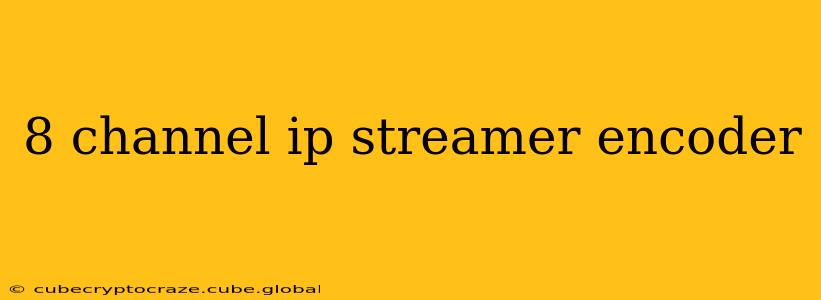The world of video streaming is constantly evolving, and for businesses and individuals needing to stream multiple channels simultaneously, an 8-channel IP streamer encoder is a game-changer. This device allows for the simultaneous encoding and streaming of eight separate video sources, making it ideal for various applications like security surveillance, live event broadcasting, and IPTV systems. But choosing the right one can be daunting. This guide will help you understand the key features, benefits, and considerations involved in selecting an 8-channel IP streamer encoder.
What is an 8-Channel IP Streamer Encoder?
An 8-channel IP streamer encoder is a hardware device that takes eight separate video inputs (typically from cameras or other video sources) and converts them into digital streams suitable for transmission over an IP network. This process, called encoding, compresses the video data to reduce bandwidth requirements while maintaining acceptable video quality. The encoded streams are then sent to a streaming server or platform, ready for distribution to viewers. Think of it as a powerful central hub for managing and broadcasting multiple video feeds simultaneously.
Key Features to Consider When Choosing an 8-Channel IP Streamer Encoder
Several factors determine the suitability of an 8-channel IP streamer encoder for your specific needs. Here are some key features to consider:
-
Resolution and Frame Rate: Higher resolutions (like 1080p or 4K) provide better image quality, but require significantly more bandwidth. The frame rate (frames per second, or FPS) affects the smoothness of the video. Consider the resolution and frame rate needed for your application and your network's bandwidth capacity.
-
Encoding Standards: Different encoding standards (like H.264, H.265/HEVC, and VP9) offer varying levels of compression efficiency and video quality. H.265/HEVC generally provides better compression than H.264, allowing for higher quality video at lower bitrates.
-
Network Connectivity: Ensure the encoder supports the network protocols and interfaces you require (e.g., Ethernet, Wi-Fi). Consider the network's bandwidth and stability as insufficient bandwidth can significantly impact streaming quality.
-
Input/Output Interfaces: Check the available input and output interfaces to ensure compatibility with your existing video sources and monitoring systems. Common inputs include BNC, HDMI, SDI, and composite video.
-
Audio Support: Many encoders support audio input and embedding, allowing for synchronized audio with the video stream. Consider the number of audio channels and the type of audio inputs supported.
-
Management Software: A user-friendly management interface simplifies configuration, monitoring, and control of the encoder. Remote access capabilities are crucial for managing multiple encoders across different locations.
-
Scalability and Expandability: Consider whether you might need to expand your system in the future. Some encoders offer options for adding more channels or upgrading components.
What are the benefits of using an 8-channel IP streamer encoder?
The advantages of using an 8-channel IP streamer encoder are numerous, including:
- Centralized Management: Easily manage and monitor multiple video streams from a single interface.
- Cost-Effectiveness: Often more cost-effective than using eight separate single-channel encoders.
- Scalability: Easily expandable to accommodate future growth.
- Flexibility: Supports diverse video sources and streaming platforms.
- Remote Access: Manage and monitor your streams remotely.
What types of applications use 8-channel IP streamer encoders?
This versatile technology finds use across various sectors:
- Security and Surveillance: Monitoring multiple security cameras across a wide area.
- Live Event Broadcasting: Streaming multiple camera angles of a live event.
- IPTV Systems: Delivering multiple television channels over an IP network.
- Traffic Monitoring: Observing multiple traffic points simultaneously.
- Industrial Monitoring: Monitoring different aspects of an industrial process.
How much bandwidth do I need for an 8-channel IP streamer encoder?
The bandwidth required depends heavily on the resolution, frame rate, and encoding standard used. Streaming eight 1080p channels at 30 FPS using H.264 could require a substantial amount of bandwidth, potentially exceeding 100 Mbps. Using a more efficient codec like H.265/HEVC can significantly reduce this requirement. Accurately calculating your bandwidth needs requires careful consideration of all these factors.
What are the different types of 8-channel IP streamer encoders?
The market offers various types, differentiating themselves in features, price, and capabilities. Some offer advanced features like advanced analytics, AI-powered features, or specific integrations with streaming platforms. Researching specific models and comparing their specifications is crucial for finding the ideal fit.
Conclusion
Choosing the right 8-channel IP streamer encoder involves considering various technical specifications and your specific application needs. By carefully evaluating factors like resolution, frame rate, encoding standards, network connectivity, and management software, you can select a solution that meets your requirements and delivers reliable, high-quality video streaming across multiple channels. Remember to consult the specifications of individual models before making a purchase decision to ensure optimal performance and compatibility with your infrastructure.
